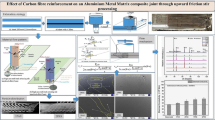Abstract
This paper is the second part of the series of papers, which establishes the finite element model (FEM) of single grain cubic boron nitride (CBN) bonding for quantitative analysis and optimization of the bonding force. The FEM model of the bonding force involves the geometric modelling of the bonding couple, the determination of the mechanical properties of the electroplating layer, and the development of the algorithm for CBN grain dislodgement. By modelling the actual grain shape and bond material, the FEM model is verified through the bonding force experiments based on the inclined micro-cutting test as of part 1. Finally, the comprehensive correlation of the bonding force with the bonding layer thickness and grain orientation is established through response surface methodology.
Similar content being viewed by others
References
C. Guo, Z. Shi, H. Attia, D McIntosh; Power and Wheel Wear for Grinding Nickel Alloy with Plated CBN Wheels; Annals of the CIRP Vol. 56/1/2007
Teicher U, Ghosh A, Chattopadhyay AB, Kunanz K (2006) On the grindability of titanium alloy by brazed type monolayered superabrasive grinding wheels. Int J Mach Tools Manuf 46:620–622
Buhl S, Leinenbach C, Spolenak R, Wegener K (2013) Failure mechanisms and cutting characteristics of brazed single diamond grains. Int J Adv Manuf Technol 66:775–786
Pinto FW, Vargas GE, Wegener K (2008) Simulation for optimizing grain pattern on engineered grinding tools[J]. CIRP Ann Manuf Technol 57:353–356
Zhen Bing H, Ranga K (2003) On the mechanics of the grinding process—Part I. Stochastic nature of the grinding process[J]. Int J Mach Tools Manuf 43:1579–1593
Fujimoto M, Ichida Y (2008) Micro fracture behavior of cutting edges in grinding using single crystal cBN grains[J]. Diam Relat Mater 17:1759–1763
Toenshoff HK, Denkena B (2013) Basics of cutting and abrasive processes[M]. GmbH & Co. K, Springer-Verlag Berlin and Heidelberg
Klocke F (2010) Manufacturing processes 2: grinding, honing, lapping[M]. GmbH & Co. K, Springer-Verlag Berlin and Heidelberg
Xuekun L, Sebastian W, Geng Z, Rong YK (2014) The modelling and experimental verification of the grinding wheel topographical properties based on the ‘through-the-process’ method. Int J Adv Manuf Technol 70:649–659
Doman DA, Warkentin A, Bauer R (2009) Finite element modelling approaches in grinding. Int J Mach Tools Manuf 49:109–116
Li X, Yiping L, Li Q, Li F, Rong Y (2013) The study on the influences of superabrasive grain spatial orientation for microcutting processes based on response surface methodology. Int J Adv Manuf Technol 67:1527–1536
Xuekun Li, Sebastian wolf, Tianxing Zhu, Geng Zhi Yiming Rong; Modelling and analysis of the bonding mechanism of CBN grains for electroplated super-abrasive tools—part 1: the analysis of the bonding mechanism (submitting to the International Journal of Advanced Manufacturing Technology)
Author information
Authors and Affiliations
Corresponding author
Rights and permissions
About this article
Cite this article
Li, X., Zhi, G., Wolf, S. et al. Modelling and analysis of the bonding mechanism of CBN grains for electroplated superabrasive tools—part 2: finite element modelling and experimental verification. Int J Adv Manuf Technol 77, 43–49 (2015). https://doi.org/10.1007/s00170-014-6412-4
Received:
Accepted:
Published:
Issue Date:
DOI: https://doi.org/10.1007/s00170-014-6412-4




